Reed Ghazala’s latest generation of instruments is here, gazing back at us with glass eyeballs and dubbed with names like “photon clarinet.” The father of circuit bending also espouses a new conceptual frame and philosophy – errism. And to err is human, but also is cat.
Yes, Reed Ghazala’s cat has knocked over an omelette. But more on that later.
It’s normally difficult to say that someone “invented” something in music. And indeed, maybe the first “circuit bend” was arguably Theremin’s accidental radio experiments.
Louis and Bebe Barron’s cybernetic approach and Bebe’s description of organisms is even closer.
But in the case of circuit bending the concept, because Reed Ghazala uniquely described the technique of making instruments that evolved from short circuits, the genesis of this idea has a moment in time, a place, a person – a specific desk drawer. The face that this “mind-bending experience” might well apply to other instruments makes it all the more powerful, and spans from the 60s to the phenomenon of Casio keyboards disappearing from eBay and events like Bent Festival.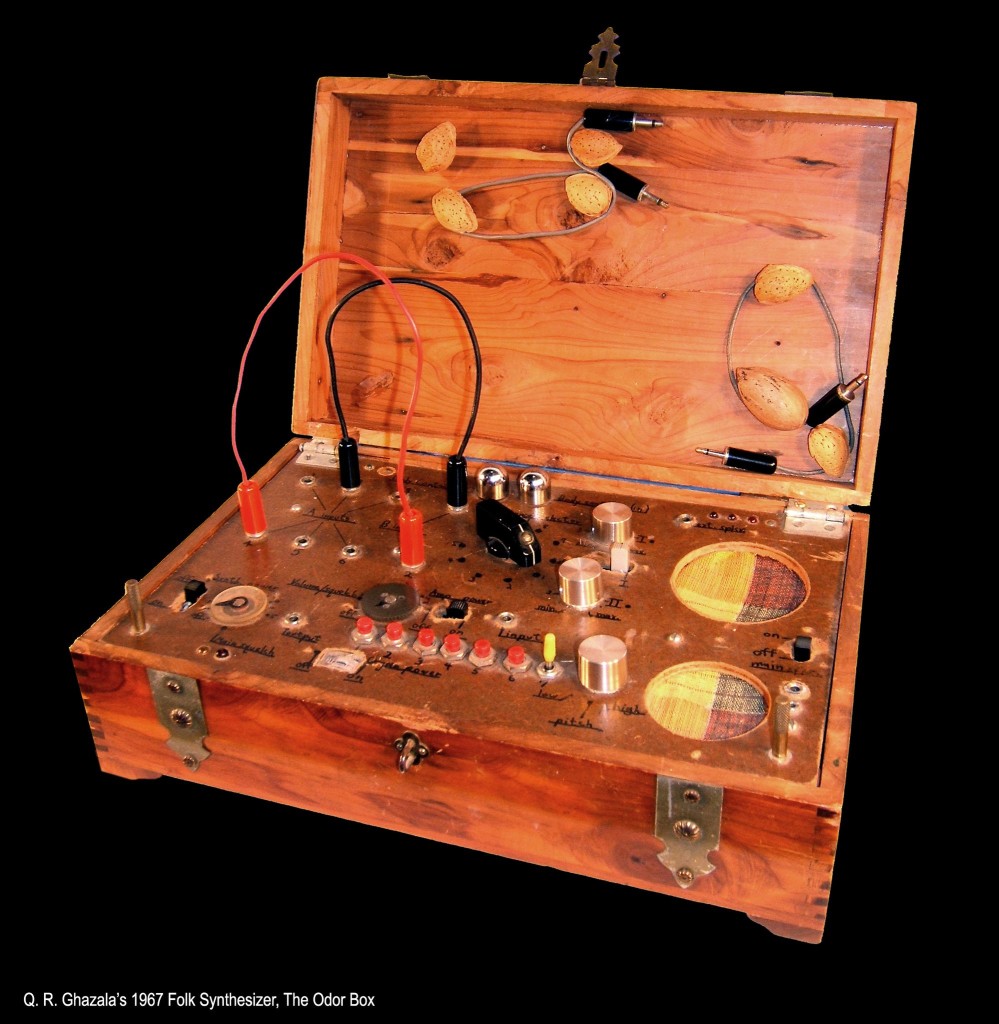
And most importantly, by producing instruments that can’t be replicated (or predicted), it is a field of practice where not just a particular innard of an instrument has non-linearity, but the instrument itself evolves to singular, non-linear forms.
And that means we have a lot of new one-of-a-kind musical creatures emanating from Reed’s workshop, so it’s high time to check in on them. Here’s Reed speaking a few years in a nice, compact interview (and describing this more clearly than I do), for some additional background:
First, here’s some of the latest of what he’s been up to. Finding animal features and organic life in devices was always part of Reed’s unique take. Now he’s been adding human eyes to his synths.
As he posted recently:
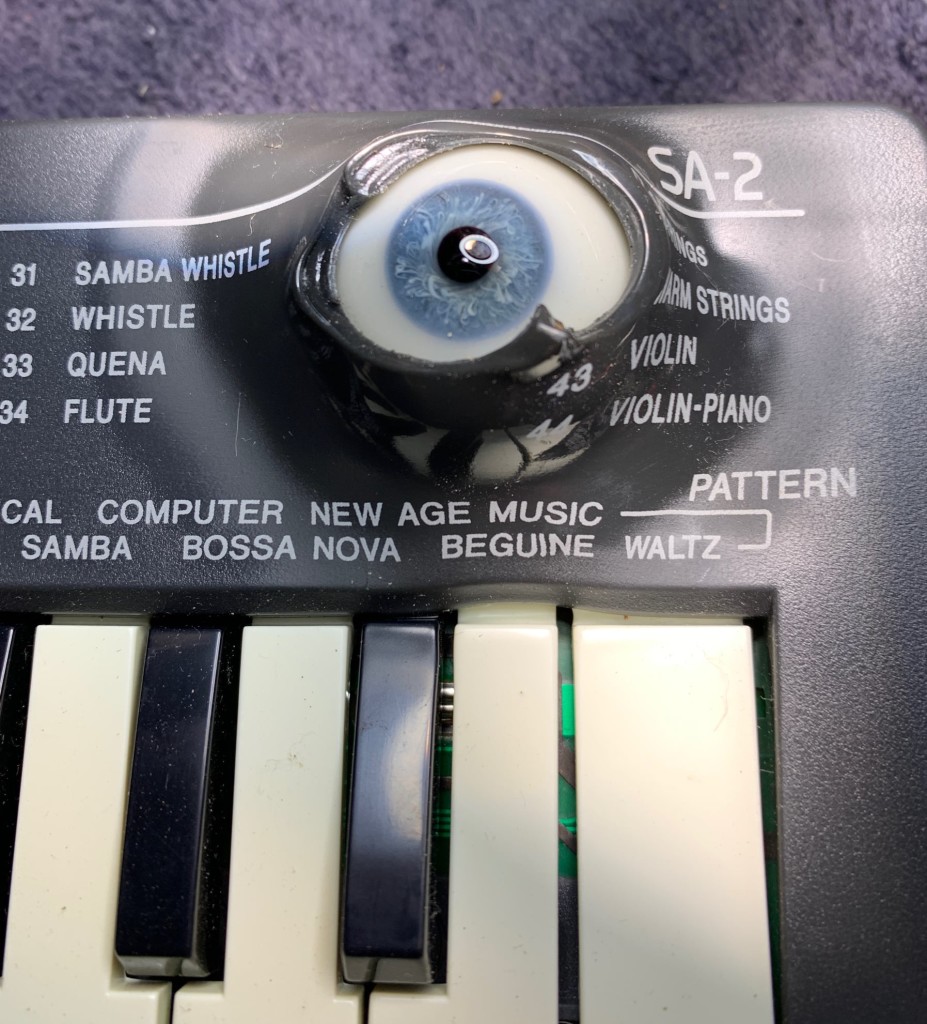
This is a test-mounting of a full-sized medical-industry glass eye (ocular prosthetic) hand-blown in Germany by a master of this bizarre craft. Rare. These eyes are no longer made of glass, rather, a medical-grade acrylic, and cost between $2,500 – $9,000 per eye. And they are not as detailed as the hand-blown glass eyes I acquired decades ago and still use today.I’d never inset a huge human eye into a SA-2 Aleatron before, and I had a request for one. So I needed to do a test before I could assure that it would work.
Well, as you see, it worked, and worked perfectly. Beautiful eye, beautiful mount. The eye will glow blue with red flashes at volume peaks, kinda startling to watch even though the color-play is lovely (reds, blues, purples).
And then there’s a lot more (copying text from images for accessibility):
Morpheum
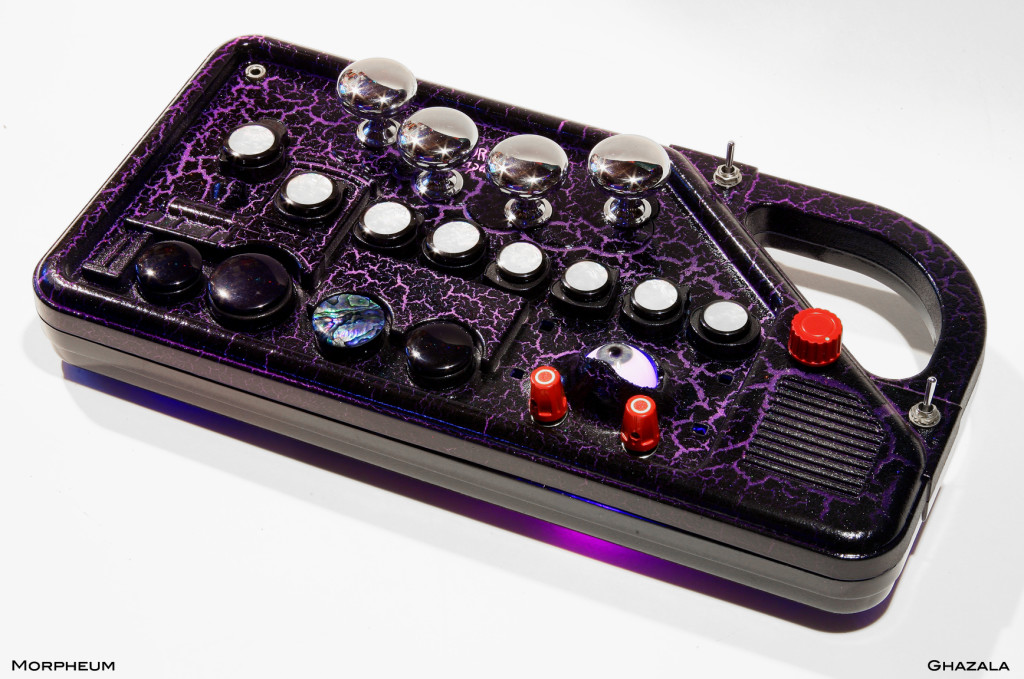
ALIEN ANIMAL VOICE SYNTHESIZER.
The Morpheum instrument is used to create real-time alien animal cries for lead voice work
1- Set dials to create very low-frequency sounds (counter-clockwise near the bottom of their range)
2- Press the ANIMAL KEYS while touching both the ANIMAL CONTACTS at the same time.
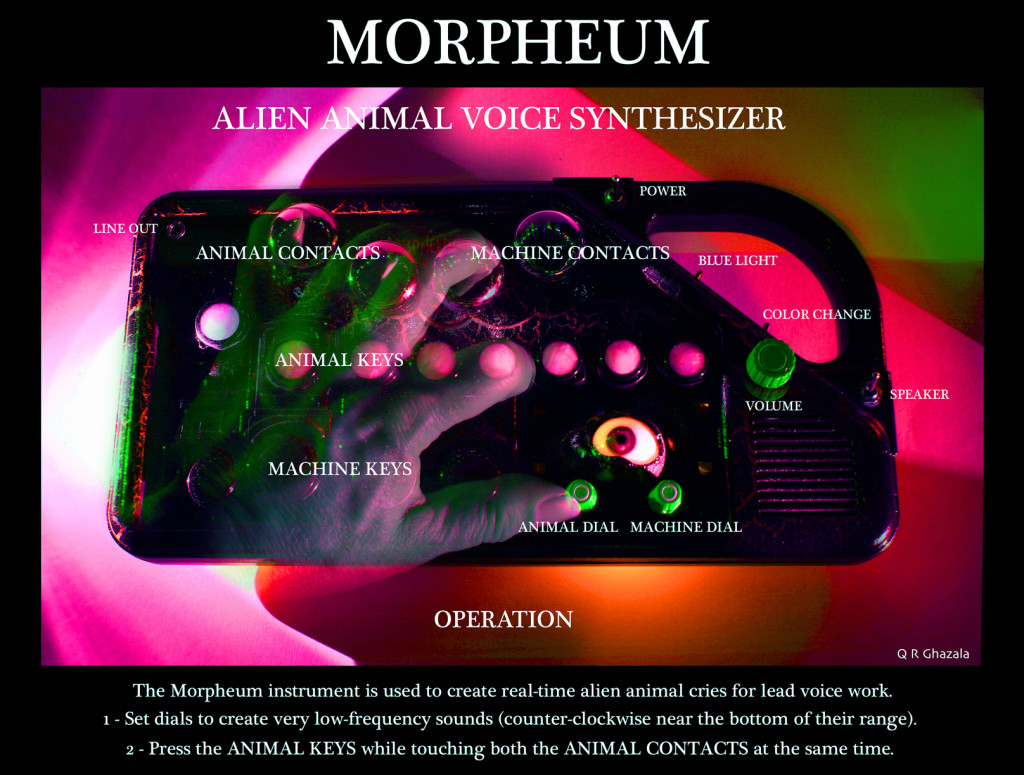
Eyed Insectaphone
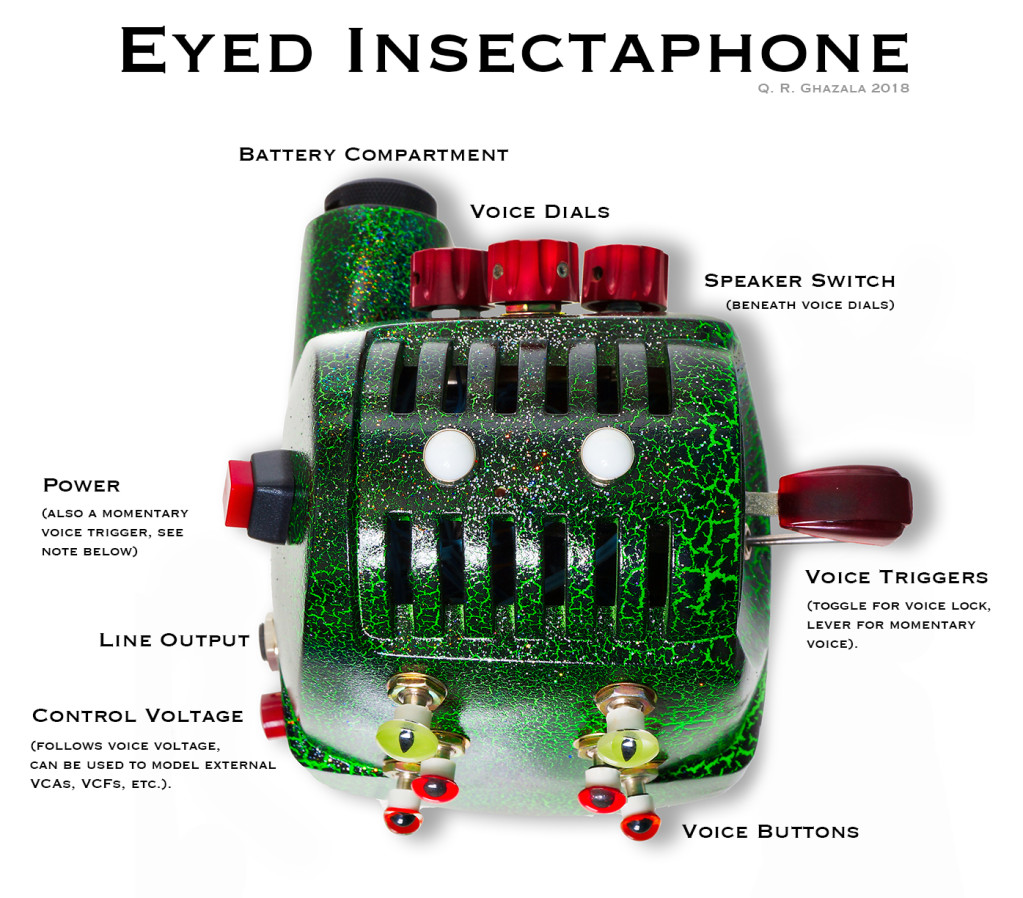
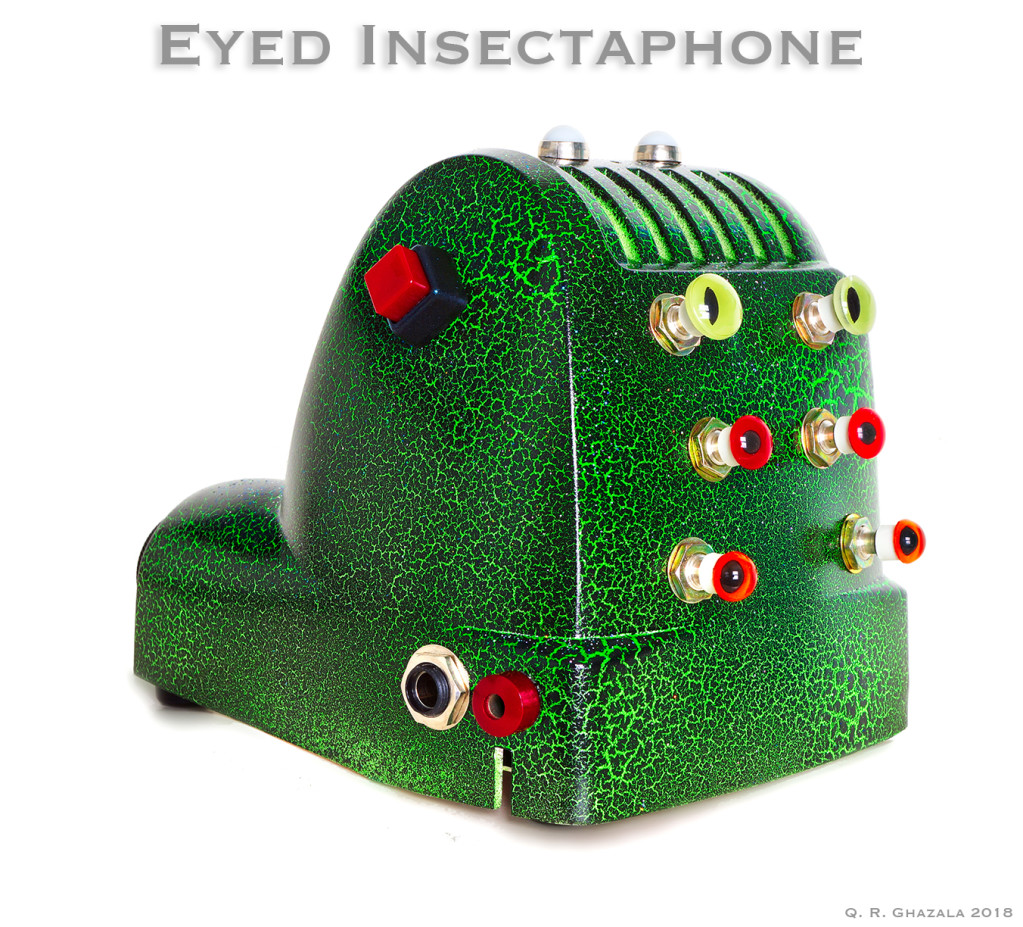
Modified Buddha boxes and misc.
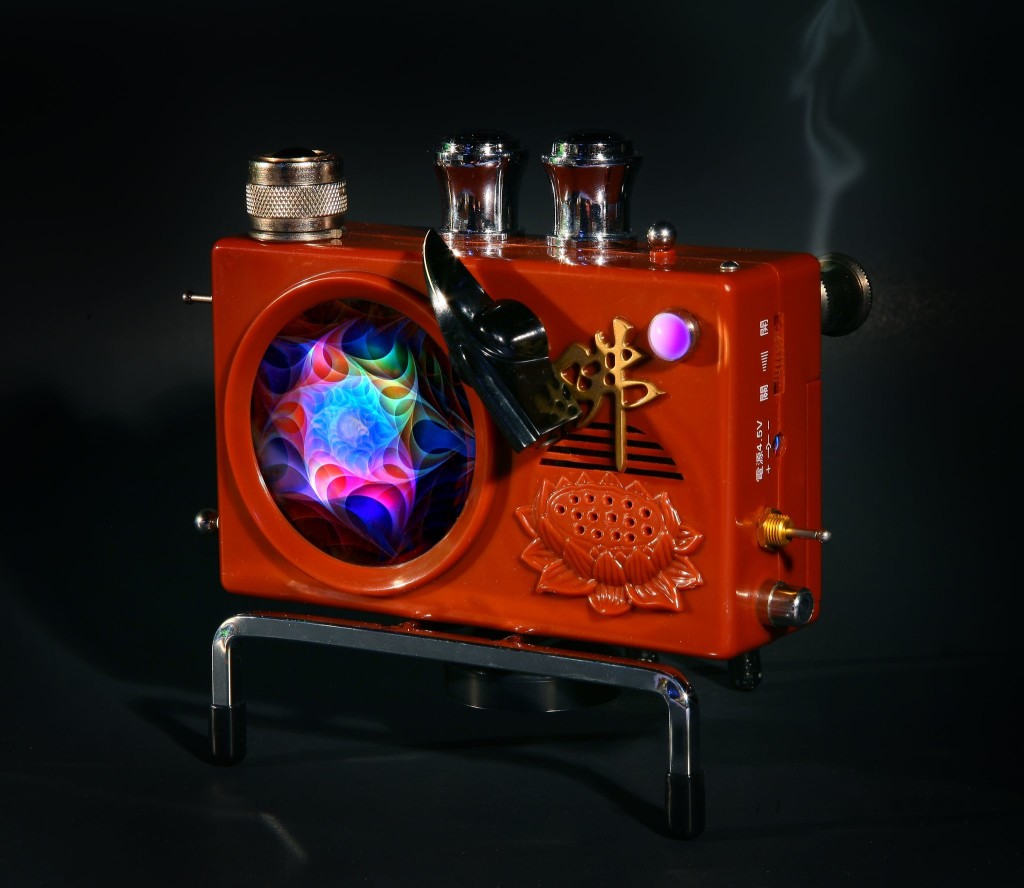
Fuzzy Buddha Melt.
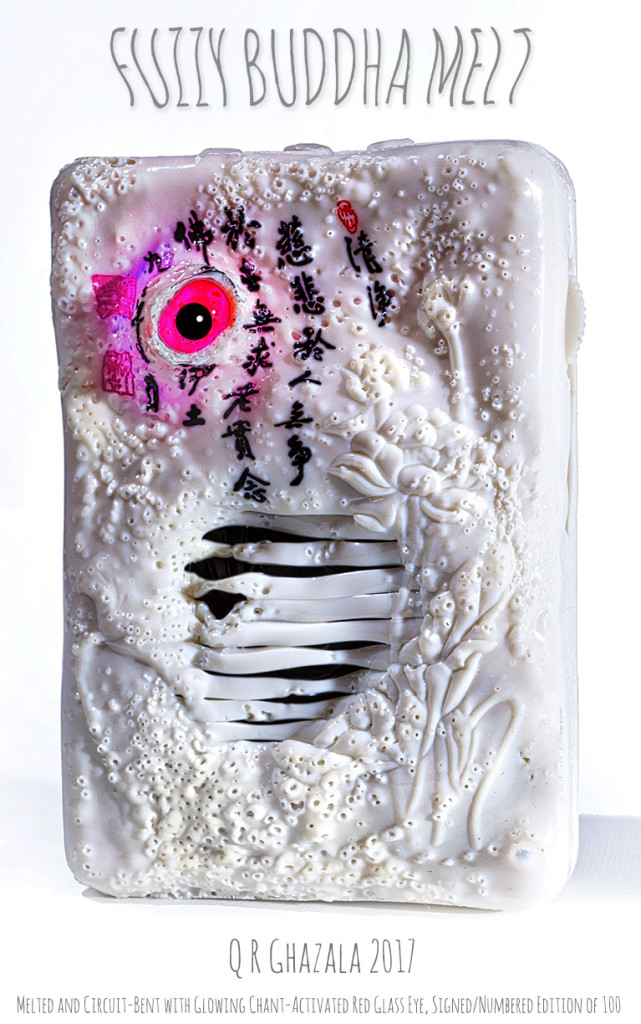
Hypercolor and Hyperlight Aleatron
Hypercolor Aleatron.
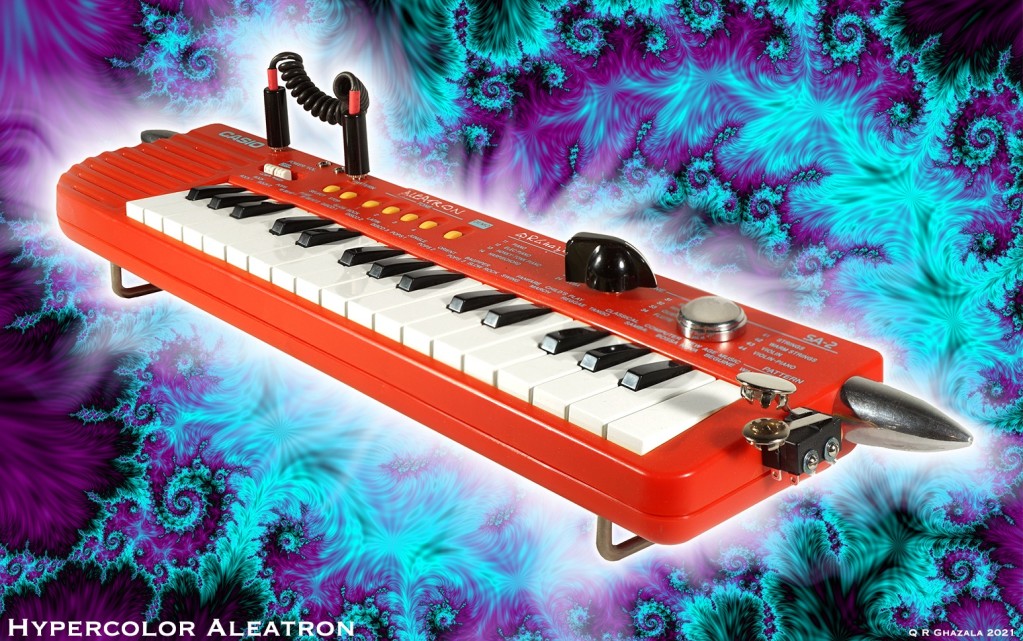
Hyperlight Aleatron, with both “Chance Music Engine” and “8-point light show.”
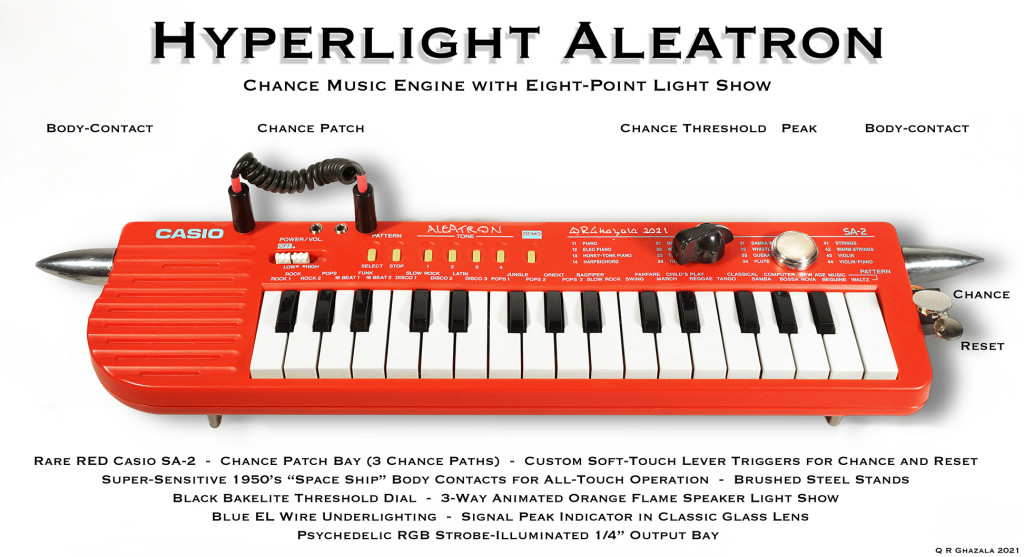
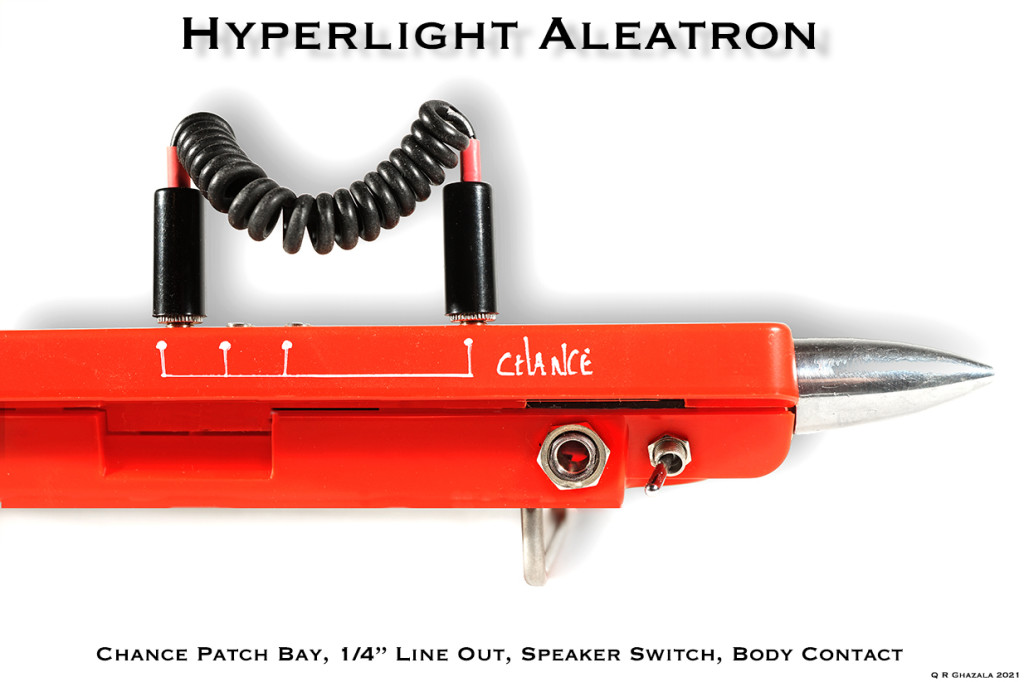
Hyperlight Aleatron:
RARE RED CASIO SA-2
CHANCE PATCH BAY (3 CHANCE PATHS)
CUSTOM SOFT-TOUCH LEVER TRIGGERS FOR CHANCE AND RESET
SUPER-SENSITIVE 1950’S “SPACE SHIP’ BODY CONTACTS FOR ALL-TOUCH OPERATIONBRUSHED STEEL STANDS
BLACK BAKELITe THRESHOLd DIAL
BLUe EL WIRE UNDERLIGHTING
3-WAY ANIMATED ORANGE FLAME SPEAKER LIGHT SHOW
SIGNAL PEAK INDICATOR IN CLASSIC GLASS LENS
PsYCHEDELIC RGB STROBE-ILLUMINATED 1/4′ OUTPUT BAY
Kronos Aleatron
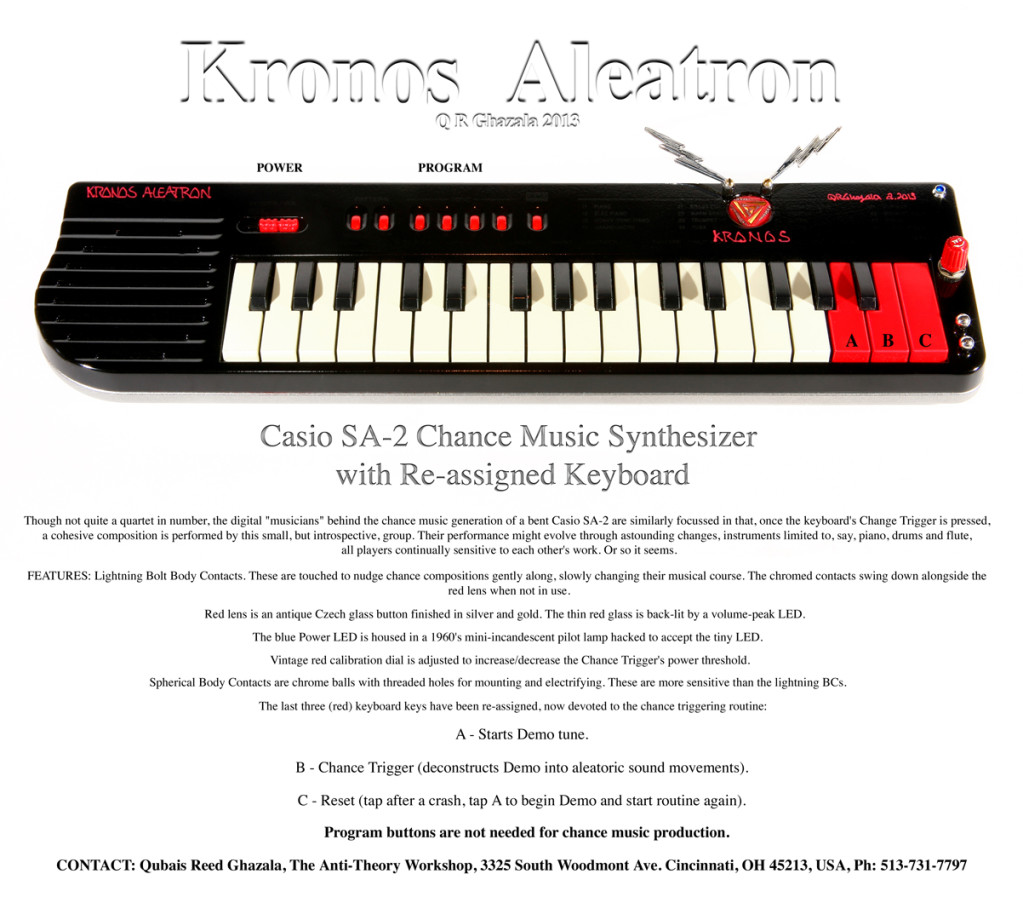
Casio SA-2 Chance Music Synthesizer
with Reassigned KeyboardThough not quite a quartet in number, the digital “musicians” behind the chance music generation of a bent Casio SA-2 are similarly focused in that, once the keyboard’s Change Trigger is pressed, a cohesive composition is performed by this small, but introspective, group. Their performance might evolve through astounding changes, instruments limited to, say, piano, drums and flute, all players continually sensitive to each other’s work. Or so it seems.
FEATURES: Lightning Bolt Body Contacts. These are touched to nudge chance compositions gently along, slowly changing their musical course. The chromed contacts swing down alongside the
red lens when not in use.
Red lens is an antique Czech glass button finished in silver and gold. The thin red glass is back-lit by a volume-peak LED.
The blue Power LED is housed in a 1960’s mini-incandescent pilot lamp hacked to accept the tiny LED
Vintage red calibration dial is adjusted to increase/decrease the Chance Trigger’s power threshold.
Spherical Body Contacts are chrome balls with threaded holes for mounting and electrifying. These are more sensitive than the lightning BCs.
The last three (red) keyboard keys have been re-assigned, now devoted to the chance triggering routine:
A – Starts Demo tune.
B – Chance Trigger (deconstructs Demo into aleatoric sound movements).
C – Reset (tap after a crash, tap A to begin Demo and start routine again)
SA-2 Frytronic Aleatron
RIP Fry’s Electronics (the California store), but this one does actually involve coils from a vape pen and a “FRY” control.

Three vape coils are attached to heat-sensitive components of the SA-2 Aleatron.
“FRY” dials control heat intensity.
Pushbuttons
‘”””‘2,” and “3” deliver full-voltage to the coils for immediate response.
Thank You Louis and Bebe Barron lest I be forbidden to plan it this way.
Chance Orchestron
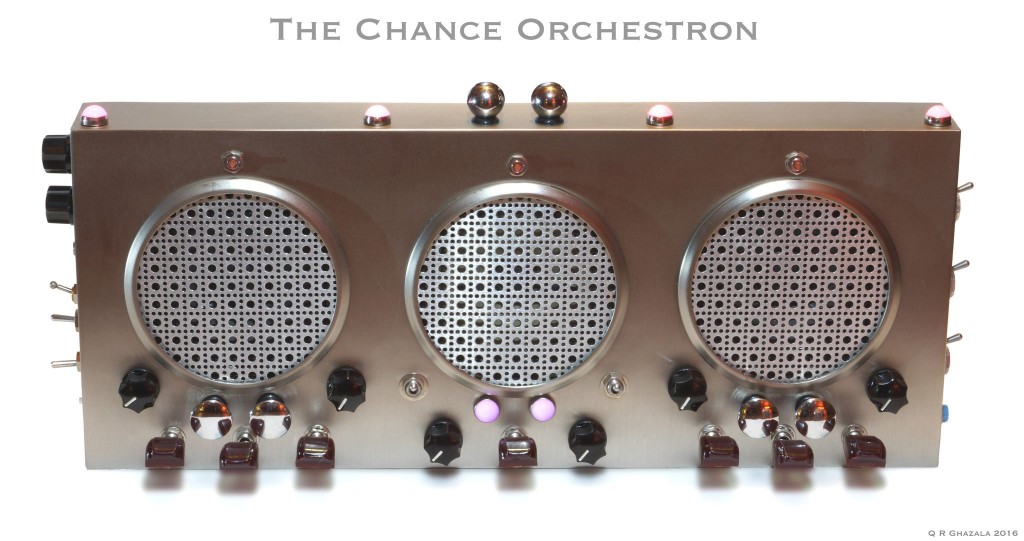
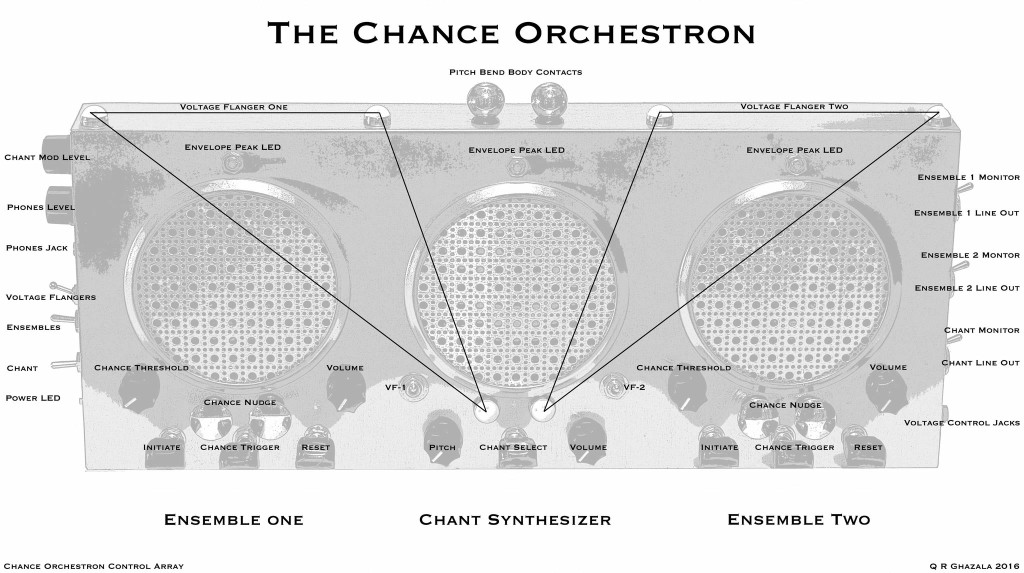
Photon Clarinet
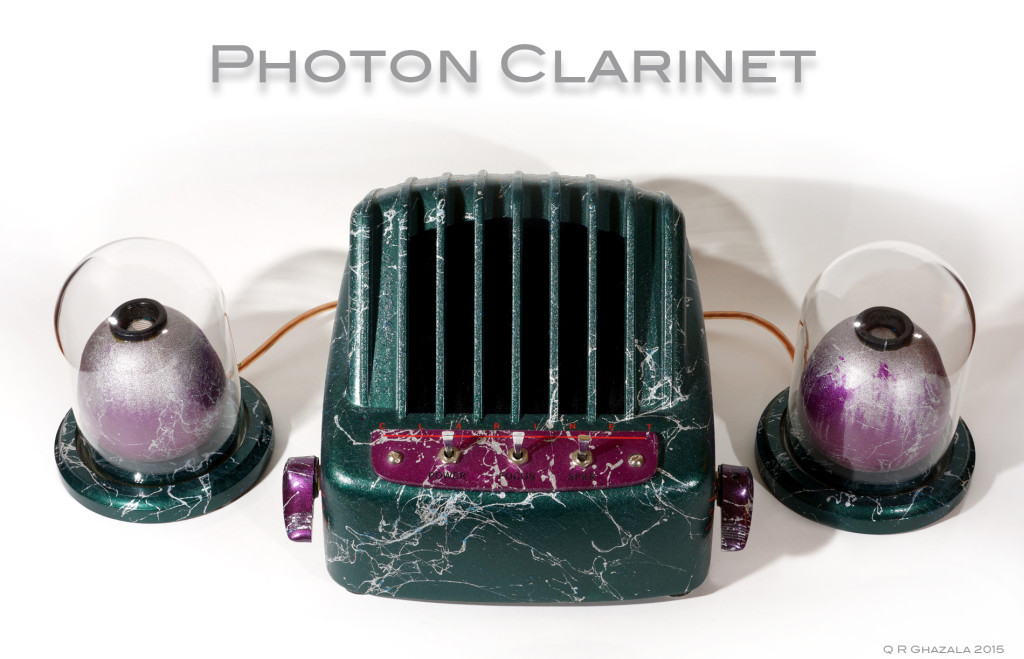
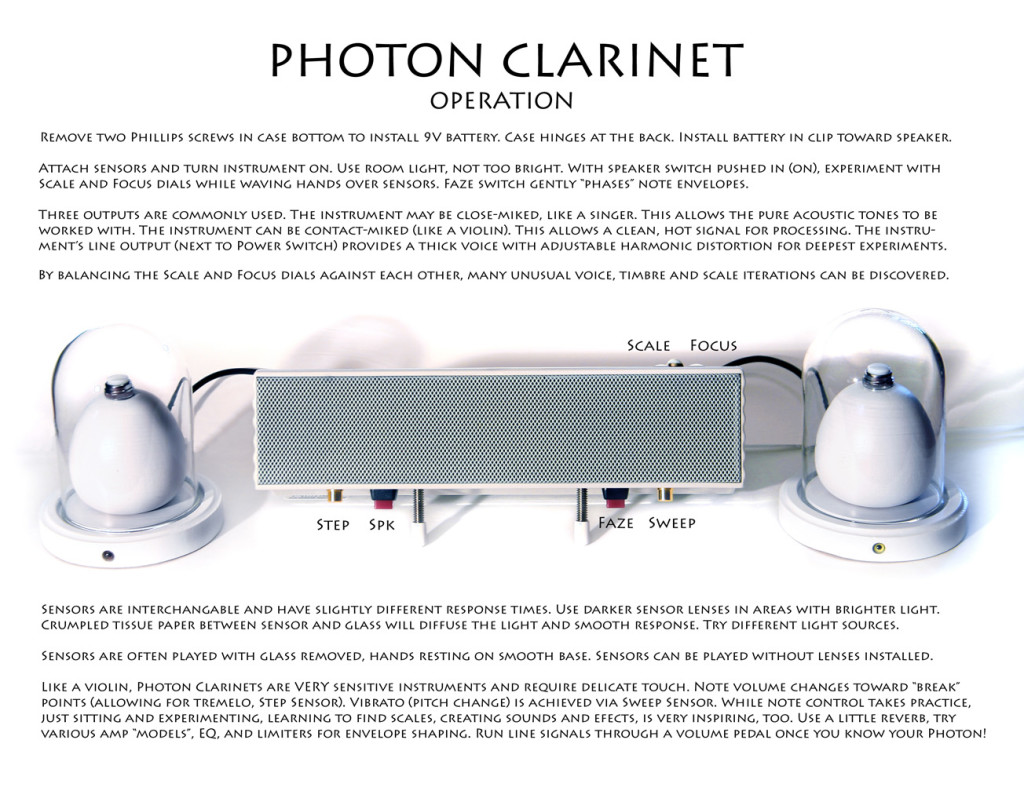
Easy explanation here:
REMOVE TWO PHILLIPS SCREWS IN CASE BOTTOM TO INSTALL 9V BATTERY. CASE HINGES AT THE BACK. INSTALL BATTERY IN CLIP TOWARD SPEAKER.
ATTACH SENSORS AND TURN INSTRUMENT ON. USE ROOM LIGHT, NOT TOO BRIGHT. WITH SPEAKER SWITCH PUSHED IN (ON). EXPERIMENT WITH
SCALE AND FOCUS DIALS WHILE WAVING HANDS OVER SENSORS. FAZE SWITCH GENTLY “PHASES” NOTE ENVELOPES.
THREE OUTPUTS ARE COMMONLY USED. THE INSTRUMENT MAY BE CLOSE-MIKED, LIKE A SINGER. THIS ALLOWS THE PURE ACOUSTIC TONES TO BE
WORKED WITH. THE INSTRUMENT CAN BE CONTACT-MIKED (LIKE A VIOLIN). THIS ALLOWS A CLEAN, HOT SIGNAL FOR PROCESSING. THE INSTRU-
MENT’S LINE OUTPUT (NEXT TO POWER SWITCH) PROVIDES A THICK VOICE WITH ADJUSTABLE HARMONIC DISTORTION FOR DEEPEST EXPERIMENTS.
BY BALANCING THE SCALE AND FOCUS DIALS AGAINST EACH OTHER. MANY UNUSUAL VOICE. TIMBRE AND SCALE ITERATIONS CAN BE DISCOVERED.SENSORS ARE INTERCHANGABLE AND HAVE SLIGHTLY DIFFERENT RESPONSE TIMES. USE DARKER SENSOR LENSES IN AREAS WITH BRIGHTER LIGHT.
CRUMPLED TISSUE PAPER BETWEEN SENSOR AND GLASS WILL DIFFUSE THE LIGHT AND SMOOTH RESPONSE. TRY DIFFERENT LIGHT SOURCES.
SENSORS ARE OFTEN PLAYED WITH GLASS REMOVED, HANDS RESTING ON SMOOTH BASE. SENSORS CAN BE PLAYED WITHOUT LENSES INSTALLED.
LIKE A VIOLIN, PHOTON CLARINETS ARE VERY SENSITIVE INSTRUMENTS AND REQUIRE DELICATE TOUCH. NOTE VOLUME CHANGES TOWARD “BREAK”
POINTS (ALLOWING FOR TREMELO, STEP SENSOR). VIBRATO (PITCH CHANGE) IS ACHIEVED VIA SWEEP SENSOR. WHILE NOTE CONTROL TAKES PRACTICE,
JUST SITTING AND EXPERIMENTING, LEARNING TO FIND SCALES, CREATING SOUNDS AND EFECTS, IS VERY INSPIRING, TOO. USE A LITTLE REVERB, TRY
VARIOUS AMP “MODELS”, EQ, AND LIMITERS FOR ENVELOPE SHAPING. RUN LINE SIGNALS THROUGH A VOLUME PEDAL ONCE YOU KNOW YOUR PHOTON!
Singer Insectaphone
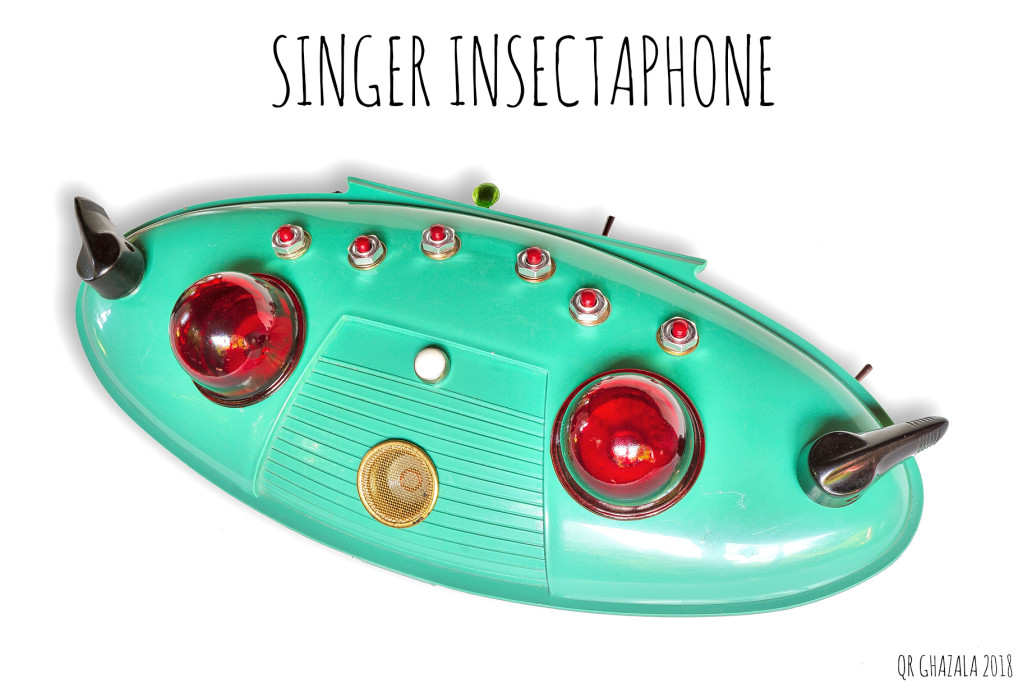
Unigon Incantor
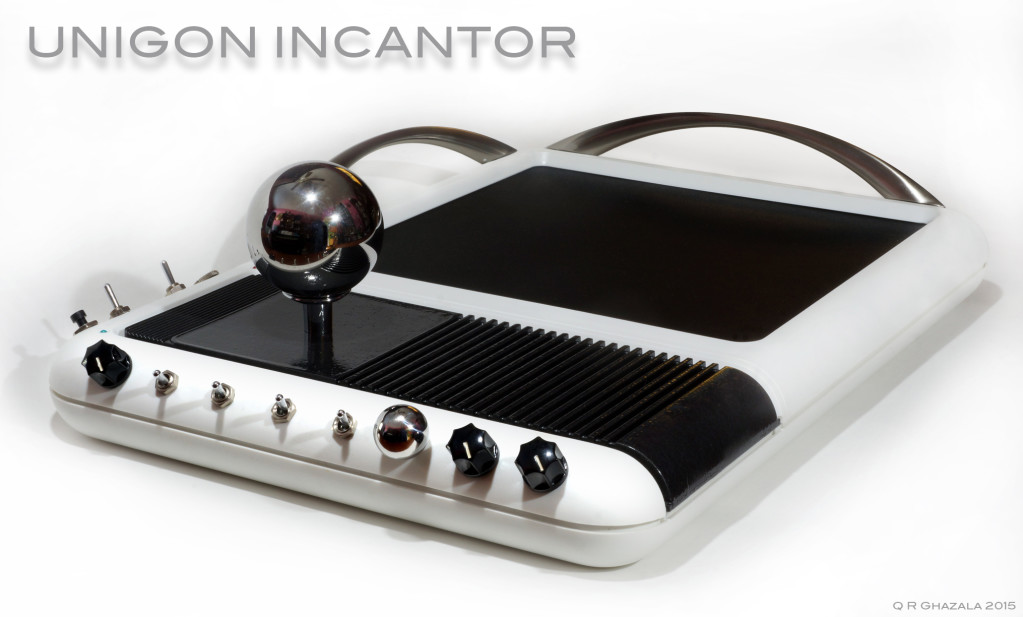
Buddhan Cyclops
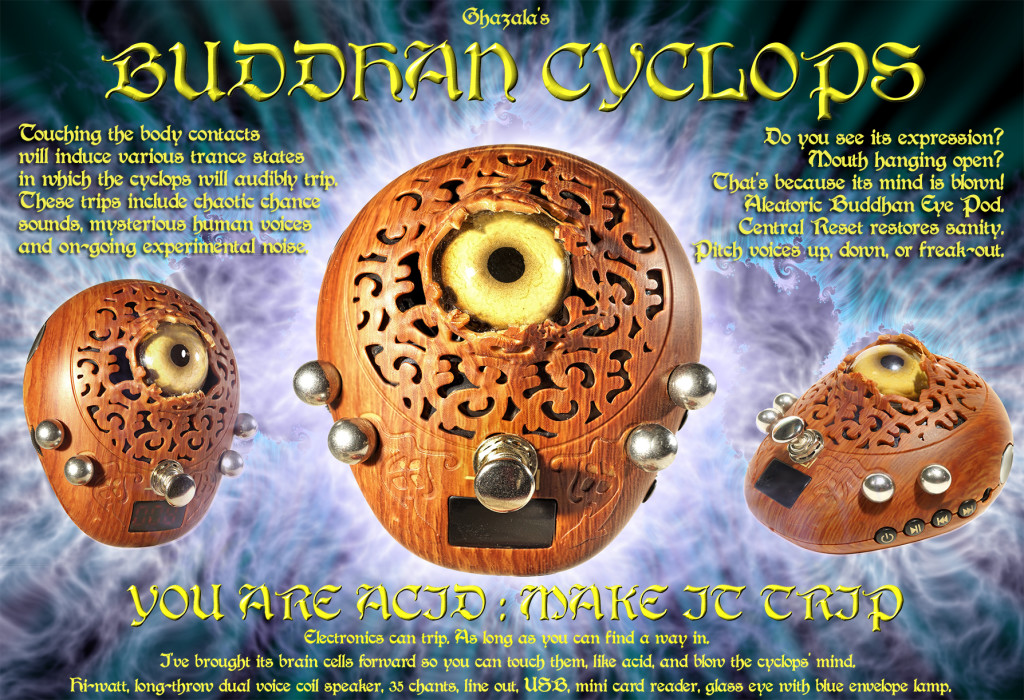
“Touching the body contacts will induce various trance states in which the cyclops will audibly trip… do you see its expression? Mouth hanging open. That’s because its mind is blown.”
This one has a control for pitching voices up, down, or “freak-out” with a Central Reset button for “restoring sanity.”
Noiznik
Okay, really apologies to all my friends who come from the area of the former USSR, but I think this one is actually based on a noise machine from the Communist period?
I know some ex-Soviet engineers who would love the design.

• Antenna body-contact plays different notes like an aleatoric electric flute
• Old-School loud and powerful discrete transistor circuit board
• Body-contact 1 for chance radio voices
• Body-contacts 2, 3 and 4 produce various “touch-theremin” voices
• Piezo line-out, Power and Envelope LEDs, heavy solid steel body-contacts
ZHA十¥卡仁卡IY卡K?
Zhat Receiver? 3HAT? I think you should spell this however you like.
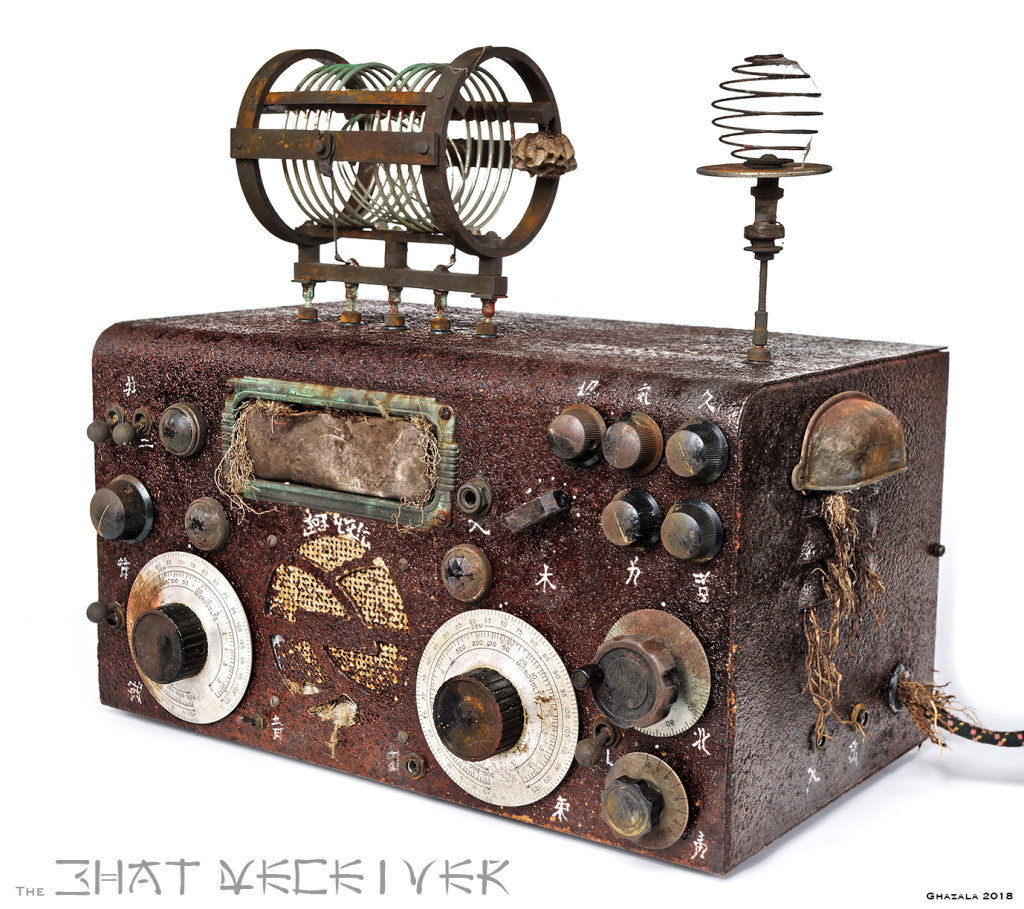
Errism
As wondrous as all these creations are, I think I most appreciate the “new and important concept” Reed is pondering these days, errism. Again, transcribing his text for accessibility.
But what he says about the limitations of Cage, Cunningham, and friends has been one that often comes up. Maybe error can go beyond (prepared) chance. I’ll let him explain – this was a test to see who would read this far:
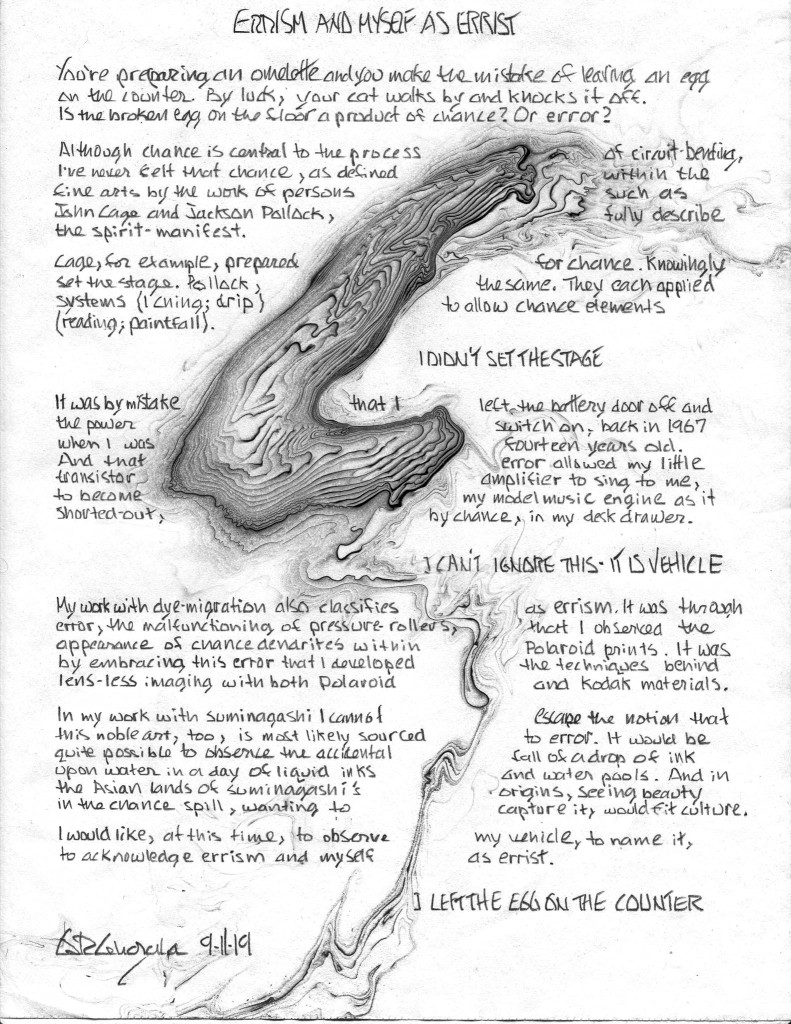
ERRISM AND MYSELF AS ERRIST
You’re preparing an omelette and you make the mistake of leaving an egg on the counter. By luck, your cat walks by and knocks it off. Is the broken egg on the floor a product of chance? Or error?
Although chance is central to the process of circuit-bending, I’ve never felt that chance, as defined within the fine arts by the work of persons such as John Cage and Jackson Pollock, fully describe[s] the spirit-manifest.
Cage, for example, prepared for chance. Knowingly set the stage. Pollock, the same. They each applied systems (I Ching, drip) to allow chance elements (reading, paintfall).
I DIDN’T SET THE STAGE
It was by mistake that I left the battery door off and the power switch on, back in 1967 when I was fourteen years old. And that error allowed by little transistor amplifier to sing to me, to become my model music engine as it was shorted out, by chance, in my desk drawer.
I CAN’T IGNORE THAT IT IS VEHICLE
My work with dye-migration also classifies as errism. It was through error, the malfunctioning of pressure-rollers, that I observed the appearance of chance dendrites within Polaroid prints. It was by embracing this error that I developed the technique behind lens-less imaging with both Polaroid and Kodak materials.
In my work with suminagashi [Japanese paper marbling] I cannot escape the notion that this noble art, too, is most likely sourced to error. It would be quite possible to observe the accidental fall of a drop of ink upon water in a day of liquid inks and water pools. And in the Asian land of suminagashi’s origins, seeing beauty in the chance spill, wanting to capture it, would fit culture.
I would like, at this time, to observe my vehicle, to name it, to acknowledge errism and myself as errist.
I LEFT THE EGG ON THE COUNTER
R. Ghazala, September 11, 2019
I’ll stop here, there are more but I haven’t published them yet (including a new concept I’m introducing to circuit-bending). This pic is of course the circuit that got me started, the movement can be traced to this (is earlier version was destroyed you may recall). It still exists, I still demo it when I do talks. A new and important concept is errism…
Lastly, here is some video of both the Japanese and Turkish paper marbling:
Reed’s official site: